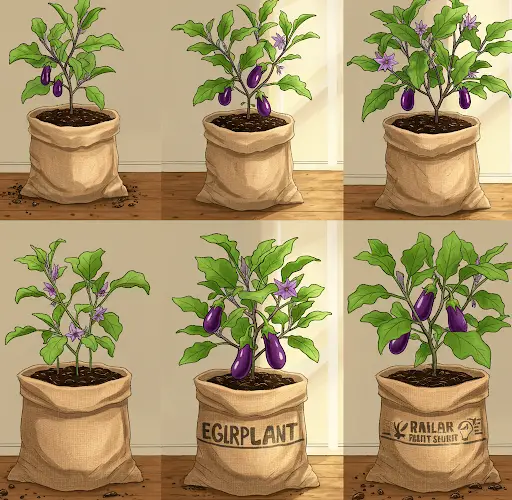Growing eggplant at home is not only rewarding but also incredibly practical for gardeners with limited space. With the right method, you can grow healthy, productive eggplants in something as simple as a sack. This technique is ideal for balconies, patios, rooftops, or any area where traditional garden beds aren’t available.
Sack gardening is a space-saving, low-cost, and efficient method for cultivating vegetables at home. Let’s explore how to grow eggplants in sacks — easily and successfully.
Why Grow Eggplants in a Sack?
Sack gardening offers several benefits:
-
Space-efficient: Perfect for small spaces or urban gardening.
-
Portable: Sacks can be moved to follow sunlight or avoid harsh weather.
-
Affordable: Reuses materials you may already have at home.
-
Easy maintenance: Less bending and weeding compared to garden beds.
Eggplants, with their sturdy stems and deep roots, adapt well to container growing, especially in sacks where soil depth can be customized.
Materials You’ll Need
To get started, gather the following:
-
A clean sack (woven plastic rice sack, jute sack, or grow bag) – at least 40 liters in size
-
Good quality potting soil or a mix of garden soil, compost, and sand
-
Eggplant seeds or healthy seedlings
-
Watering can or hose
-
Organic fertilizer (compost, vermicompost, or liquid feed)
-
Small sticks or bamboo for plant support
Make sure your sack is strong, has no holes in the bottom, and can hold soil without tearing.
Step 1: Preparing the Sack
Choose a sack that is at least 40–50 cm tall and wide. These dimensions give eggplant roots enough room to grow deep and strong.
-
Poke drainage holes in the bottom if they don’t already exist.
-
Roll down the sides of the sack to make it easier to fill and manage early on.
-
Place the sack in a sunny location that receives at least 6–8 hours of sunlight per day.
Step 2: Soil Preparation
Eggplants thrive in loose, well-draining, nutrient-rich soil. A recommended mix includes:
-
50% garden soil
-
30% compost or well-rotted manure
-
20% sand or coco peat for aeration
Mix these well and fill the sack up to two-thirds full. Lightly moisten the soil before planting.
Step 3: Planting Eggplants
You can either sow seeds directly or transplant young seedlings.
From Seeds:
-
Plant 2–3 seeds about half an inch deep in the center of the sack.
-
Water gently and keep the soil moist.
-
Seeds typically germinate within 7–14 days.
From Seedlings:
-
Dig a small hole in the center and carefully place the seedling.
-
Firm the soil gently around the stem.
After planting, water the sack until you see moisture draining from the bottom.
Step 4: Providing Support
As the eggplant grows, it will produce heavy fruits that need support. Insert a small stick or bamboo stake into the soil next to the main stem and tie the plant gently with soft twine. This prevents the plant from toppling over and helps promote upright growth.
Step 5: Watering and Sunlight
Eggplants love warmth and sunlight. Keep the sack in a spot where it receives full sun. Water regularly — about once daily in hot weather or every other day when it’s cooler.
Avoid letting the soil dry out completely, but don’t overwater either. Soggy soil can lead to root rot.
Step 6: Feeding the Plant
Eggplants are heavy feeders. To ensure steady growth and healthy fruiting:
-
Add compost or organic fertilizer every 2–3 weeks.
-
Use a liquid fertilizer like compost tea or diluted fish emulsion during flowering and fruiting stages.
Mulching the top of the sack with dry leaves or straw helps retain moisture and reduce weed growth.
Step 7: Pruning and Maintenance
-
Pinch off the first few flowers to help the plant focus on vegetative growth.
-
Remove yellowing leaves or any side shoots that drain energy from the main stem.
-
Watch for pests like aphids, flea beetles, and whiteflies. Neem oil or insecticidal soap works well for control.
Eggplants are hardy but benefit from regular inspection to catch early signs of problems.
Step 8: Harvesting
Eggplants are usually ready for harvest 60–80 days after transplanting. Harvest fruits when they are shiny and firm, but before the skin becomes dull and the seeds harden.
To harvest:
-
Use a sharp knife or scissors to cut the stem about an inch above the fruit.
-
Frequent harvesting encourages the plant to produce more.
Depending on the variety and conditions, a single eggplant plant can yield 5–10 fruits or more over the growing season.
Reusing the Sack
After harvesting, you can reuse the same sack for a new eggplant cycle or for growing other vegetables like peppers, tomatoes, or leafy greens. Just refresh the soil by mixing in new compost and removing old roots.
Conclusion
Growing eggplants at home using sacks is a fantastic way to enjoy fresh, organic produce without needing a traditional garden. With just a sack, some soil, and sunlight, you can cultivate healthy eggplants and reduce your grocery bill while enjoying homegrown flavor. This easy method is perfect for beginners and seasoned gardeners alike — and it works in almost any environment.
So roll up your sleeves, grab a sack, and start growing your own eggplants right at home!



